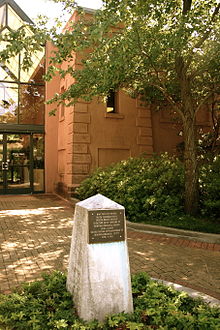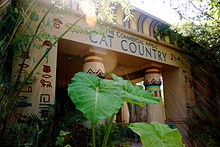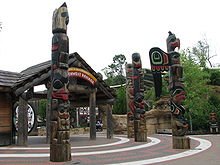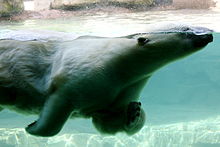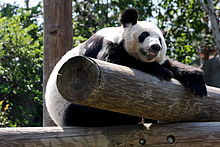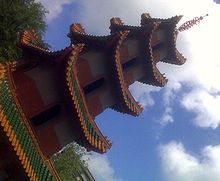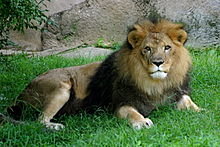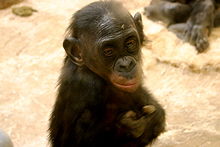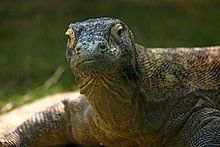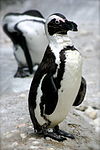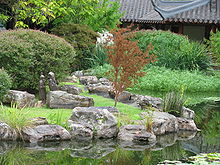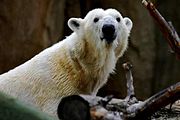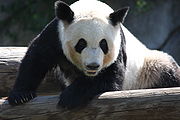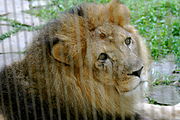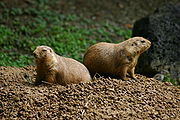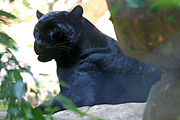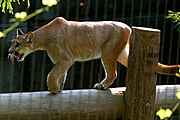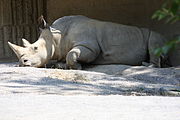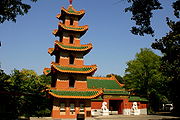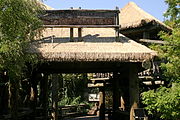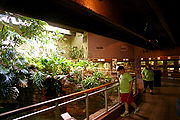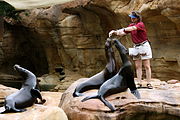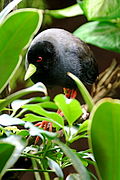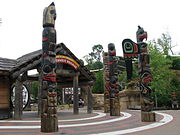- Memphis Zoo
-
Memphis Zoo 
Entrance gate at the Memphis ZooDate opened April 1906 Location Memphis, Tennessee, USA Land area 76 acres (31 ha) Coordinates 35°09′00″N 89°59′39″W / 35.1500°N 89.9943°WCoordinates: 35°09′00″N 89°59′39″W / 35.1500°N 89.9943°W Number of animals 3,500 Number of species 500 Memberships AZA[1] Major exhibits 19 spread across 3 zones Website http://www.memphiszoo.org The Memphis Zoo, located in Midtown Memphis, Tennessee, is home to more than 3,500 animals representing over 500 different species. Created in April 1906, the zoo has been a major tenant of Overton Park for more than 100 years. The land currently designated to the Memphis Zoo was defined by the Overton Park master plan in 1988, it is owned by the City of Memphis. The zoo is set on 76 acres (31 ha), of which approximately 55 acres (22 ha) are developed.
In 2008, the Memphis Zoo was ranked "#1 Zoo in the U.S." by TripAdvisor.com. The ranking was based on visitor opinions.[2]
Since the early 1990s, the Memphis Zoo has invested over $77 million for renovation and expansion. The zoo's animal inhabitants reside in three zones with 19 exhibits, such as Teton Trek, Northwest Passage and China, home to Giant Pandas Ya Ya and Le Le[3]
The Memphis Zoo is an accredited member of the Association of Zoos and Aquariums (AZA).
Contents
History
- Early 1900s
The zoo was established on April 4, 1906 with $1,200 from the Memphis Park Commission. In August, 23 cages and concrete bear enclosures were built with another $3,628 thanks to the head of the Commission, Col. Robert Galloway.[4]
Galloway Hall, the Memphis Zoo's first building, was finished in 1907. It was named in honor of Col. Galloway, but was later demolished to make room for newer exhibits.[4]
The Carnivora Building was constructed in 1909 to house the first cats at the zoo.[4] It was later replaced by Cat Country, and converted into an inner-zoo restaurant.
The Elephant House opened in 1910.[4] The building is still used, but the elephants were moved to the African Veldt exhibit.
In 1916, the Botanical Display Building opened. It was later converted into the Tropical Bird House.[4]
The Memphis Zoo acquired a round barn from the Memphis Police Department in 1923, who used the building as their stable for the mounted horse patrol in the early 1900s. The zoo's round barn exhibit is a collection of exotic hoofstock and birds.
In 1936 the zoo's first primate exhibit, Monkey Island, was built.[4] It was replaced in 1995 by Primate Canyon.
- Mid-1900s
The Aquarium was completed in 1959.[4] It is one of the oldest exhibits at the Memphis Zoo. The building houses aquatic life from both fresh and salt water environments. In 1979, it had major renovations.[4]
The Herpetarium was constructed in 1960, located across from the Tropical Bird House.[4] The Herpetarium is home to the zoo's snakes, alligators, lizards and frogs. Later in the year, the Pachyderm/Elephant exhibit was finished, and the elephants moved in from the old elephant house.[4]
- Late 1900s to Present
The zoo renovated its entrance in 1990.[4]
Cat Country, a 3-acre (1.2 ha), open-air exhibit focused on both predators and prey of the cat world, opened in 1993.[4] Tigers and lions share common space with Fennec Foxes and Meerkats. An Education Complex, Discovery Center, and the Elephant’s Trunk Zoo Shop also opened at this time.[4] The Carnivora Building that formerly housed the zoo's large cats was remodeled into The Cat House Cafe, which opened in 1994.
Three new exhibits opened in 1995.[4] Animals of the Night is devoted to nocturnal animals, and reverses their hours from normal so visitors can see them at their most active. Once Upon A Farm was built to resemble an early 1900s farm. 'Primate Canyon features naturalistic, outdoor exhibit areas for a variety of monkeys and apes.
Dragon’s Lair was opened in 1998[4] for the zoo's three Komodo Dragons, and includes outdoor and indoor areas, allowing them to stay warm during the cool winter months. A new animal hospital was also finished in 1998,[4] with separate holding and quarantine wings built on opposite ends of the building. The sick wing separates sick or injured animals from others and allows for proper recovery time. The quarantine wing is used for newly-acquired animals, which are quarantined for at least 30 days upon arrival at the zoo before being introduced to their new homes. On September 18, 1998, two plaques were dedicated in memory of musician Jeff Buckley in the Memphis Zoo's Sumatran Tiger exhibit. His mother chose that location because of his great love of the Memphis Zoo and the tigers in particular. Jeff frequently visited the zoo, had plans to become a volunteer in 1997 and, according to his mother, never left the zoo without visiting the Butterflies: In Living Color exhibit, which also opened early in 1998. The exhibit was replaced by "Birds and Bees" in late May, 2009.
In April 2003, the Memphis Zoo became one of only four U.S. zoos to exhibit the Giant Panda. One male and one female Giant Panda ("Ya Ya" and "Le Le") share their 3-acre (1.2 ha) home with several other species native to China, in the first Memphis Zoo exhibit to be built as zoogeographical exhibit. The buildings, plant life and even the sounds of China are represented in this $16 million exhibit.
The Northwest Passage exhibit opened on March 1, 2006[4] with underwater viewing for Polar Bears and Sea Lions. The animals frequently interact with visitors, and the Sea Lions are fond of following and mimicking small children.
Butterflies: In Living Color! was renovated in 2007.[4] The exhibit houses as many as 1,000 butterflies of 35 different species. There were 56 varieties of plants for the butterflies to feed on.
Construction of the Teton Trek exhibit started in February, 2008.[5] The decision to clearcut 4 acres (1.6 ha) of old growth forest in the Old Forest Arboretum in order to build the exhibit drew sustained criticism by Citizens to Preserve Overton Park, which was reorganized in response to the forest reduction,[6] and by Park Friends, Inc.[7] Approximately 14 acres of forest adjacent to the Zoo were left out of the protective area to ease opposition from Memphis Mayor A C Wharton and zoo officials.[8]
The Zoo had its largest single day attendance ever on March 17, 2009, with more than 20,450 visitors.[9] In late May, 2009, the Birds and Bees exhibit opened in the former butterfly exhibit. The butterfly garden moved outside the aviary, and is still close to the original exhibit. Longtime zoo favorite "Ann" the reticulated python died on July 28. She was 18 years old. Teton Trek was opened on October 10, and winning artists of the Teton Trek Art Contest were recognized.[10]
Exhibits
The zoo hosts modern exhibits that mimic the animals' natural habitats, such as Once Upon A Farm, Cat Country, Primate Canyon, Dragon's Lair, Animals of the Night, Tropical Bird House, Herpetarium, Aquarium, African Veldt, China, Northwest Passage, and Teton Trek. Viewing all the exhibits requires a walk of about 2 miles (3.2 km). Operating seasonally, trams provide visitors with guided tours of exhibits for a small daily fee; the trams are also useful for shuttling visitors between distant exhibits. Other attractions at the Zoo include a carousel, an area with rides, a miniature train offering a scenic view of the Once Upon A Farm exhibit, and several theme-oriented gift shops and eateries; many of these amenities operate seasonally.[11] A children's playground is located next to the Cat House Cafe, and several family picnic areas are maintained beneath groves of mature trees.
The zoo is divided into three zones that showcase a total of 19 different exhibits.
East zone
The 4-acre (1.6 ha) exhibit,[12] which opened October 2009, brings hallmark features of the Yellowstone National Park to the Memphis Zoo.[13][14] Teton Trek begins with a 25-foot (7.6 m) replica of the Old Faithful Geyser[12] and a 5,000-square-foot (460 m2) replica of the Old Faithful Inn called the Great Lodge, where interpretive information is presented in an interactive format.[12] The exhibit is home to some of the keystone species of the Yellowstone ecosystem: Grizzly Bears, Elk, Gray Wolves, Trumpeter Swans and Sandhill Cranes.[12] The exhibit's trail provides visitors with an underwater look at the bears' fishing pond and a prominent overlook atop the 25-foot (7.6 m) replica of Yellowstone's Firehole Falls.[12]
Home to the zoo's Polar Bears, this $23 million exhibit opened on March 1, 2006,[15] and features an underwater viewing building, sea lion observation bubble and a 500-seat amphitheater for daily sea lion shows.[15] Its theme is a tribute to the culture of the First Nations people and the animals and horticulture of the Pacific Northwest.[15] Messages of conservation inspired by Chief Seattle, a famous Native American chief, are sprinkled though out the exhibit.[15] Six hand-carved totem poles that stand throughout the area received a Native American blessing ceremony when they arrived at the zoo.[15] The Northwest Passage is also home to the zoo's American Bald Eagles, Black Bears, and White-necked Ravens. [15]
- African Veldt
African Elephants and Giraffe are joined by Zebras, Grant's gazelle, White Rhinoceros and Ostriches in this area.[15] The zoo's African Cranes, Bontebok, Lechwe and Scimitar Oryx also live here.[15] The zoo finished enlarging the elephant exhibit in 2006; it now features a pool that allows elephants to submerse and bathe.
- Crocodile Cove
Nile crocodiles are featured in this exhibit, which provides a deep pool for swimming and a shoreline for basking.[16] Visitors often have to look hard to find these stealthy reptiles, despite their large size.
- World of Waterfowl
In this exhibit, two wooden bridges take visitors through a wetland. It is home to around 30 Chilean Flamingos and a variety of other waterfowl.[17]
- Birds and Bees
This exhibit opened in May 2009. It features an up-close look at two honey bee hives. Displays inside the exhibit explain what makes bees special and the role they play in agriculture. The indoor bee exhibit leads to an outdoor aviary that features approximately 500 budgies, commonly known as parakeets. In addition to viewing these colorful birds, visitors can feed them using millet seed-heads attached to sticks that are available for a small fee.
Central zone
- China
Opened in April 2003,[18] this $16 million exhibit is a zoogeographical area the Memphis Zoo constructed after it became one of only four U.S. zoos to exhibit the Giant Panda. Other animals showcased in this effort to preserve Chinese species include Asian Small-clawed Otter, Père David's Deer, White-Cheeked Gibbon, Francois' Langur, and an assortment of colorful birds (see list).[18]
- Primate Canyon
This exhibit was opened in 1995[18] and features naturalistic, outdoor exhibit areas for Western Lowland Gorillas, Sumatran Orangutans and Siamang Gibbons. Other animals in the area are Lion-tailed Macaques, the Mona Monkey, Sulawesi Macaques, and the Eastern Black-and-white Colobus,[18] and the Savanna Baboon.
- Commercial Appeal Cat Country
This 3-acre (1.2 ha),[18] open-air exhibit houses African Lions, Cheetahs, Reeve's Muntjac, Leopard, Meerkats, Caracal Lynx, Capybara, Klipspringer, Cougars, Sumatran Tiger, Bengal Tiger, Crested Screamer, Jaguar, Snow Leopard, Red Panda, and Ocelot.[18] The zoo employed cultural architecture native to the land of the species on exhibit (for example, temple ruins surround the Sumatran Tiger exhibit).[18] The old Carnivora Building, where the cats used to live, was renovated to become the Memphis Zoo's primary restaurant - the Cat House Café.[18]
- Hippos
A mother/daughter duo of hippos named "Julie" and "Splish" are showcased.[18]
- Bonobos
Six Bonobos (including a baby Bonobo born in 2005) live in this indoor/outdoor hybrid exhibit across from the China exhibit.[18] The Bonobo is endangered, and is found in the wild only in the Democratic Republic of Congo.
- Animals of the Night
This exhibit reverses the daily cycle of nocturnal animals,[18] giving visitors the chance to see night-dwellers at their most active. The exhibit is developed around a central bat flyway which enables visitors to get a close-up view of the bats in flight or feeding. Also exhibited are a wide range of other species—from aardvark to wombat (see list).[17]
West zone
This exhibit was specifically built for largest lizard in the world. The zoo's three dragons share a special exhibit with outdoor and indoor areas allowing them to stay warm during the cool winter months.[19] Keepers hold a feeding demonstration of the Komodo Dragons on Saturdays.
- Tropical Bird House
A variety of colorful birds in outdoor enclosures can be seen by visitors at the entrance to the zoo's Tropical Bird House.[19] The building is home to exotic bird species from around the world (See list). The exhibit features a walk-through aviary which allows visitors close contact to a number of birds, especially during feeding time.
- Aquarium
The Aquarium is one of the oldest exhibits at the Memphis Zoo and houses aquatic life from both fresh and salt water environments.[19] Some of the more notable animals include: Nile softshell turtle, Fly River turtle, mata mata turtle, Electric eel, Red bellied piranha, and Archer fish (See list). The electric eel exhibit has a unique feature that converts the eel's electric pulses into a sound and visual display.
- Penguin Rock
Over 30 African Penguins live across from the zoo's rides area at Penguin Rock.[19] American White Pelicans are located nearby.[19]
- Once Upon A Farm
This exhibit was built to resemble an early 1900s farm.[19] It is home to Caspian Horse, Domestic Goat, Prairie Dog, Domestic Chicken, Miniature Cow, Guinea Hog, Pekin Duck and Miniature Donkey.[19] In addition to farm animals, a vegetable garden, cotton patch, and rows of corn provide visitors with some of the essential elements of a southern farm during the growing season.
Located across from the Tropical Bird House, the herpetarium is home to the zoo's snakes, alligators, lizards, and frogs (see list). It includes the rare Louisiana Pine Snake in addition to some of the most venomous snakes in the world, including the Green mamba[19] and Gaboon viper. In one exhibit, a simulated shallow pond provides favorable breeding habitat for the highly endangered Mississippi Gopher Frog; this exhibit also features a slide presentation describing the Zoo’s participation in the frog’s recovery program.
The Round Barn is home to Gerenuks,[19] which are known by their extremely long necks. Keepers encourage their foraging behavior by placing tall bamboo stems in their exhibit. This exhibit also houses Abyssinian Ground-Hornbill, Warthog, Red River Hog, Nyala, Yellow-backed Duiker, Dik Dik, Klipspringer, and Dama Gazelle.[17]
Landscaping
China Exhibit Interior.
Landscaping plays a key role in each of the Zoo's three zones, both within exhibits and along the interconnecting trails.[20] Water features, such as ponds, waterfalls, fountains, and streams, are dominant elements of the overall design, in addition to faux rock formations which blend into the containment walls of the animals' enclosures. Other key elements of the landscaping are a diverse mix of trees, shrubs, and seasonal herbaceous plants.
Most of the larger trees are native species, which include sweetgum, sycamore, tulip poplar and a host of different oaks and hickories.[21] Common shrubs include colorful native species, such as American beautyberry, oakleaf hydrangea, southern bayberry, and witch hazel, plus numerous exotic shrubs selected for their individual merits. Some exhibits feature plants that support the exhibit's theme, such as the Chinese fringetrees and Chinese snowball viburnums in the China Exhibit and several species of western conifers, maples, and birches in the Northwest Passage and Teton Trek Exhibits.
Several gardens are maintained within the Zoo, where the plants are the featured items.[22] In addition, tropical plants are grown in several areas during summer months; species include banana plants, elephant ears, hibiscuses, and oleanders growing above a groundcover of coleus and ornamental sweet potato.
Events
The Memphis Zoo sponsors an wide variety of special events with the overall theme—Always Something To Do. These include: Horticultural Tours (periodic), Plant Sale (April), Zoo Boo with its Haunted Forest (October), Zoo Lights with over 1 million holiday lights, Santa, live reindeer, and magic show (November/December), Zoo Rendezvous (September), Zoo Snooze (periodic), and many more.[23] There are also a wide assortment of educational activities throughout the year for school-aged children.
The future
The Memphis Zoo has two major projects in their future plans with funding efforts currently underway.
- Zambezi River Hippo Camp—This exhibit will feature animals common to the Zambezi River basin in eastern Africa—hippos, flamingos, Okapi, and Nile crocodiles. The hippo area will have a below-water viewing deck similar to that in the Northwest Passage Exhibit.[24] This new exhibit will be built where the World of Waterfowl and Meadow Amphitheater are currently located.
- Chickasaw Bluffs—This low-impact nature trail will wind through 15 acres (6 ha) of the Old Forest Arboretum of Overton Park that are located within the Zoo's boundaries. Signs located along the trail will allow Zoo visitors to learn about native plants and animals and to gain an appreciation for the forest. Proposed educational messages include the important role that forests play in wildlife habitat, climate, and the cycling of water, oxygen, and carbon.[25]
Incidents
On January 8, 2008, a stray dog entered the Memphis Zoo through a service door and leapt into the tiger exhibit before officials could apprehend it. Zoo staff distracted the tigers and the dog, although with various wounds, was able to walk out of the exhibit and survived.[26]
Gallery of animals
See also: List of animals at the Memphis ZooMemphis Zoo Giant PandaAfrican LionBlack Leopard or PantherPumaChina ExhibitSea Lion ShowBlack CrakeNorthwest PassageGrizzly cubs, Teton TrekReferences
- ^ "List of Accredited Zoos and Aquariums". aza.org. AZA. http://www.aza.org/current-accreditation-list/. Retrieved 23 March 2011.
- ^ "TripAdvisor's Call of the Wild: Top 10 U.S. Aquariums and Zoos". TripAdvisor.com. http://www.tripadvisor.com/PressCenter-i199-c1-Press_Releases.html. Retrieved 2008-08-07.
- ^ . Wolff, Cindy (2008-04/20). "Memphis Zoo striving to create more humane, educational atmosphere with 20-year plan". Commercial Appeal. http://www.commercialappeal.com/news/2008/apr/20/habitat-overhaul/. Retrieved 2008-04-20.
- ^ a b c d e f g h i j k l m n o p q r "History". memphiszoo.org. Memphis Zoo. http://memphiszoo.org/history. Retrieved 9 November 2011.
- ^ Wolff, Cindy (2008-05-03). "Group upset zoo took out 139 trees to build Teton Trek". Commercial Appeal. http://www.commercialappeal.com/news/2008/mar/05/old-forest-04/. Retrieved 2008-04-19.
- ^ Meek, Andy. "Group Opposes Clear-Cutting For Zoo Exhibit". The Daily News (Memphis, TN). http://www.memphisdailynews.com/editorial/Article.aspx?id=36263. Retrieved 2008-04-19.
- ^ The groups subsequently pursued a successful, 16-month campaign to have the Arboretum designated as a State Natural Area by the Tennessee General Assembly. "Forest group upset at Memphis Zoo for removing trees". WMC-TV Memphis. 2008-03-05. http://www.wmctv.com/global/story.asp?s=7969977. Retrieved 2008-04-19.
- ^ "Legislature Protects Overton Park Forest", 'The Commercial Appeal', May 21, 2011; accessed August 9, 2011.
- ^ "Record-breaking 20,450 visitors at the Memphis Zoo in Overton Park". Jim Weber/Commercial Appeal. 2009-03-17. http://www.commercialappeal.com/photos/2009/mar/17/106937/. Retrieved 2009-03-17.
- ^ Memphis Zoo: Art Contest Winners.
- ^ Memphis Zoo: Facilities and amenities.
- ^ a b c d e "Teton Trek". memphiszoo.org. Memphis Zoo. 3 June 2009. Archived from the original on 19 November 2011. http://www.memphiszoo.org/tetontrek.
- ^ Memphis Zoo: Teton Trek
- ^ Memphis Zoo: Teton Trek Press Kit.
- ^ a b c d e f g h "East Zone Exhibits". Archived from the original on 20 July 2006. http://web.archive.org/web/20060720163313/http://www.memphiszoo.org/default.aspx?pid=115.
- ^ Memphis Zoo: Crocodile Cove
- ^ a b c "Memphis Zoo". Memphis Zoological Association (Used with permission). http://www.memphiszoo.org. Retrieved 2008-09-16.
- ^ a b c d e f g h i j k "Central Zone Exhibits". Archived from the original on 21 July 2006. http://web.archive.org/web/20060721032013/http://www.memphiszoo.org/default.aspx?pid=113.
- ^ a b c d e f g h i "West Zone Exhibits". Archived from the original on 17 July 2006. http://web.archive.org/web/20060717231202/http://www.memphiszoo.org/default.aspx?pid=114.
- ^ Memphis Zoo: Plants
- ^ Memphis Zoo: Plant blogs
- ^ Memphis Zoo: Butterfly garden
- ^ Memphis Zoo: Always something to do.
- ^ Memphis Zoo: Zambezi River Hippo Camp
- ^ Memphis Zoo: Chickasaw Bluffs
- ^ . Press, Associated (2008-01-09). "Stray Dog Recovering After Jumping Into Memphis Zoo's Tiger Pit". FOX News. http://www.foxnews.com/story/0,2933,321545,00.html. Retrieved 2008-01-09.
External links
 Media related to Memphis Zoo at Wikimedia Commons
Media related to Memphis Zoo at Wikimedia CommonsZoos of Tennessee Aquariums - Ripley's Aquarium of the Smokies
- Tennessee Aquarium
Zoos Zoos, aquariums, and aviaries Types of zoos Conservation Lists Animals Other topics - Animals in captivity
- Animal training
- Behavioral enrichment
- Captive breeding
- Frozen zoo
- Immersion exhibit
- Nocturnal house
- Wildlife conservation
- Zookeeper
- Zoology
- Portal
- Project
- Category
- Commons
Categories:- Zoos in Tennessee
- Culture of Memphis, Tennessee
- Visitor attractions in Memphis, Tennessee
- Buildings and structures in Memphis, Tennessee
- Non-profit organizations based in the United States
- Organizations established in 1906
- Organizations based in Memphis, Tennessee
Wikimedia Foundation. 2010.


